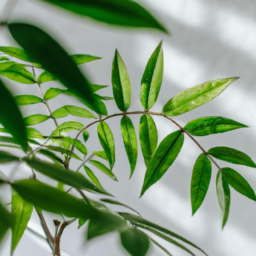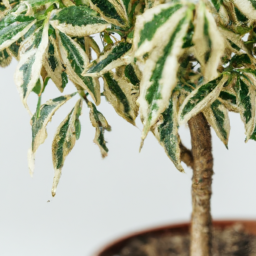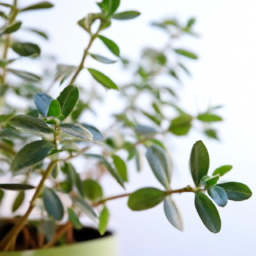
Are you looking to bring a touch of nature into your home but don’t have a lot of outdoor space? Growing a tree indoors can be a great way to add greenery and freshness to your living space. In this blog post, we will explore the best tree to grow indoors, taking into consideration factors such as size, maintenance, and aesthetic appeal. Whether you’re a seasoned plant parent or a newbie to indoor gardening, there’s a perfect tree out there for you. Let’s dive in and discover the top contenders for the title of the best tree to grow indoors.
Benefits of Growing Trees Indoors
Improved Air Quality
Growing trees indoors can significantly improve the air quality in your home. Trees are natural air purifiers, absorbing carbon dioxide and releasing oxygen through the process of photosynthesis. They can also help remove harmful toxins and pollutants from the air, such as formaldehyde and benzene. Having trees indoors can create a healthier and more breathable environment for you and your family.
In addition to improving air quality, trees can also help regulate humidity levels in your home. They release water vapor through a process called transpiration, which can help maintain optimal humidity levels for both you and your plants. This can be especially beneficial during the dry winter months when indoor air tends to be drier.
Furthermore, trees can act as natural air filters, trapping dust and other particles in their leaves and branches. This can help reduce the amount of airborne allergens in your home, leading to fewer allergy symptoms and respiratory issues. Overall, growing trees indoors can have a positive impact on your indoor air quality and overall well-being.
Aesthetic Appeal
In addition to their health benefits, trees can also add aesthetic appeal to your indoor space. They can serve as beautiful focal points, bringing a touch of nature and greenery into your home. Whether you prefer a small potted tree on a tabletop or a large statement plant in a corner, trees can enhance the visual appeal of any room.
Trees come in a wide variety of shapes, sizes, and colors, allowing you to choose the perfect tree to complement your existing decor. From the elegant and graceful weeping fig to the bold and striking fiddle leaf fig, there is a tree to suit every style and taste. You can also get creative with different planters and containers to further enhance the visual impact of your indoor trees.
In addition to their aesthetic appeal, trees can also create a sense of tranquility and calm in your home. Studies have shown that being around nature can reduce stress and anxiety levels, promoting a sense of well-being and relaxation. By incorporating trees into your indoor space, you can create a peaceful and serene environment that promotes mental and emotional wellness.
Easy to Care For
Contrary to popular belief, many trees are actually quite easy to care for indoors. With the right conditions and a little bit of attention, you can enjoy the benefits of indoor trees without a lot of maintenance. Most indoor trees thrive in bright, indirect light and moderate temperatures, making them well-suited for indoor environments.
When it comes to watering, it’s important to strike a balance between overwatering and underwatering. Most trees prefer to dry out slightly between waterings, so be sure to check the soil moisture before watering. You can also mist your tree occasionally to help increase humidity levels, especially during the dry winter months.
In terms of fertilizing, most indoor trees only need to be fertilized a few times a year during their active growing season. Use a balanced liquid fertilizer diluted to half strength to avoid over-fertilizing. Pruning is also important to maintain the shape and health of your tree, so be sure to trim any dead or damaged branches as needed.
Overall, growing trees indoors can be a rewarding and enjoyable experience. With their numerous health benefits, aesthetic appeal, and easy care requirements, trees are a great addition to any indoor space. Whether you’re a seasoned plant parent or a beginner looking to green up your home, there is a perfect tree out there waiting to be grown indoors.

Top Tree Varieties for Indoor Growth
1. Ficus
Ficus trees are a popular choice for indoor growth due to their ability to thrive in low light conditions. They are also relatively low maintenance, making them perfect for beginners. Ficus trees come in a variety of species, with the most common being the Ficus benjamina, also known as the weeping fig.
When growing a ficus tree indoors, it is important to place it in a spot with bright, indirect sunlight. Direct sunlight can scorch the leaves, while too little light can cause the tree to become leggy. Ficus trees prefer well-draining soil and should be watered when the top inch of soil feels dry to the touch. They also benefit from regular misting to increase humidity levels.
One common issue with ficus trees is leaf drop, which can be caused by changes in light, temperature, or humidity. To prevent leaf drop, try to keep the tree in a consistent environment and avoid sudden changes. Overall, ficus trees are a beautiful addition to any indoor space and can help purify the air.
2. Rubber Plant
Rubber plants are another excellent choice for indoor growth, thanks to their striking foliage and easy care requirements. These plants are known for their thick, glossy leaves that can add a touch of tropical flair to any room. Rubber plants are also effective air purifiers, making them a great choice for improving indoor air quality.
When growing a rubber plant indoors, it is important to place it in a spot with bright, indirect sunlight. Direct sunlight can cause the leaves to burn, while too little light can slow down growth. Rubber plants prefer well-draining soil and should be watered when the top inch of soil feels dry. They are also sensitive to cold drafts, so be sure to protect them from sudden temperature changes.
One common issue with rubber plants is leaf drop, which can be caused by overwatering or underwatering. To prevent leaf drop, water the plant consistently and avoid letting the soil become waterlogged. With proper care, a rubber plant can grow into a beautiful, thriving tree that will brighten up any indoor space.
3. Chinese Evergreen
Chinese evergreens are a popular choice for indoor growth due to their tolerance of low light conditions and easy care requirements. These plants are known for their attractive, variegated leaves that come in a variety of colors and patterns. Chinese evergreens are also effective air purifiers, making them a great choice for improving indoor air quality.
When growing a Chinese evergreen indoors, it is important to place it in a spot with low to moderate light. Direct sunlight can cause the leaves to burn, while too little light can slow down growth. Chinese evergreens prefer well-draining soil and should be watered when the top inch of soil feels dry. They are also sensitive to cold drafts, so be sure to protect them from sudden temperature changes.
One common issue with Chinese evergreens is root rot, which can be caused by overwatering. To prevent root rot, water the plant sparingly and allow the soil to dry out between waterings. With proper care, a Chinese evergreen can grow into a lush, beautiful tree that will thrive in any indoor environment.

Tips for Successfully Growing Trees Indoors
Choosing the Right Tree
When it comes to growing trees indoors, choosing the right tree is crucial for success. Not all trees are well-suited for indoor environments, so it’s important to do your research before making a selection. Some popular indoor tree options include the Fiddle Leaf Fig, Rubber Tree, and Peace Lily. These trees are known for their adaptability to indoor conditions and relatively low maintenance requirements.
Before selecting a tree, consider factors such as the amount of natural light available in your home, the humidity levels, and the space available for the tree to grow. Some trees require more sunlight than others, so it’s important to choose a tree that can thrive in the conditions you can provide. Additionally, consider the size of the tree at maturity and make sure you have enough space for it to grow without becoming overcrowded.
Once you’ve chosen a tree, be sure to research its specific care requirements. Different trees have different watering, fertilizing, and pruning needs, so it’s important to familiarize yourself with the care instructions for your specific tree. By choosing the right tree and providing it with the proper care, you can set yourself up for success in growing trees indoors.
Providing Adequate Light and Water
One of the most important factors in successfully growing trees indoors is providing them with adequate light and water. Most trees require bright, indirect light to thrive, so be sure to place your tree near a window where it can receive plenty of sunlight. If natural light is limited in your home, consider supplementing with a grow light to ensure your tree gets the light it needs.
When it comes to watering, it’s important to strike a balance between overwatering and underwatering. Most indoor trees prefer to dry out slightly between waterings, so be sure to check the soil moisture before watering. To prevent root rot, make sure your tree is planted in a well-draining pot and avoid letting water collect in the bottom of the pot.
In addition to light and water, it’s important to provide your tree with the proper humidity levels. Most indoor trees prefer higher humidity levels, so consider using a humidifier or placing a tray of water near your tree to increase humidity. By providing your tree with the right amount of light, water, and humidity, you can help it thrive in its indoor environment.
Pruning and Maintenance
Regular pruning and maintenance are essential for keeping your indoor tree healthy and thriving. Pruning helps promote new growth, maintain the tree’s shape, and remove any dead or damaged branches. Be sure to use sharp, clean pruning shears to prevent damage to the tree and make clean cuts.
In addition to pruning, it’s important to regularly inspect your tree for signs of pests or disease. Common indoor tree pests include spider mites, aphids, and mealybugs, so be on the lookout for any unusual spots or webbing on your tree. If you notice any pests or signs of disease, take action immediately to prevent further damage to your tree.
Finally, be sure to regularly fertilize your indoor tree to provide it with the nutrients it needs to thrive. Choose a balanced, water-soluble fertilizer and follow the instructions for application carefully. By staying on top of pruning, pest control, and fertilizing, you can help your indoor tree stay healthy and vibrant for years to come.
In a Nutshell
Looking to bring some greenery into your home but don’t have a lot of outdoor space? Growing a tree indoors can be a great way to add some natural beauty to your living space. When it comes to selecting the best tree to grow indoors, there are a few factors to consider. One popular choice is the Fiddle Leaf Fig, known for its large, glossy leaves and ability to thrive in indoor environments. This tree is relatively low-maintenance and can add a touch of elegance to any room.
Another great option for indoor tree growing is the Rubber Plant. With its thick, dark green leaves and ability to tolerate low light conditions, the Rubber Plant is a great choice for those looking for a hardy, low-maintenance tree. It also has air-purifying properties, making it a great addition to any indoor space. Whichever tree you choose to grow indoors, be sure to provide it with the proper care and attention it needs to thrive in its new environment.
Let me leave you with some FAQs:
Q1: What is the best tree to grow indoors?
A1: The best tree to grow indoors is the Ficus lyrata, also known as the Fiddle Leaf Fig. It is a popular choice for indoor plants due to its large, glossy leaves and relatively low maintenance requirements.
Q2: How much sunlight does an indoor tree need?
A2: Most indoor trees prefer bright, indirect sunlight. Place your tree near a window where it can receive plenty of natural light, but avoid placing it in direct sunlight, as this can lead to sunburned leaves.
Q3: How often should I water my indoor tree?
A3: The frequency of watering your indoor tree will depend on factors such as the type of tree, the size of the pot, and the humidity levels in your home. In general, it’s best to allow the top inch of soil to dry out before watering your tree again.
Q4: What are some other popular indoor tree options?
A4: In addition to the Fiddle Leaf Fig, other popular indoor tree options include the Rubber Plant, the Money Tree, the Parlor Palm, and the Bird of Paradise. Each of these trees has its own unique characteristics and care requirements.
Q5: How can I ensure my indoor tree stays healthy and thriving?
A5: To ensure your indoor tree stays healthy and thriving, make sure to provide it with the right amount of sunlight, water it appropriately, and periodically check for pests or diseases. Regularly dusting the leaves and periodically fertilizing the soil can also help keep your indoor tree in top condition.
Dr. Olivia Green is a botanist with over two decades of experience in indoor plant cultivation. She holds a Ph.D. in Plant Biology and has dedicated her career to researching plant behavior in controlled environments. Dr. Green is passionate about helping plant enthusiasts master the art of indoor gardening through her extensive knowledge and practical insights.


